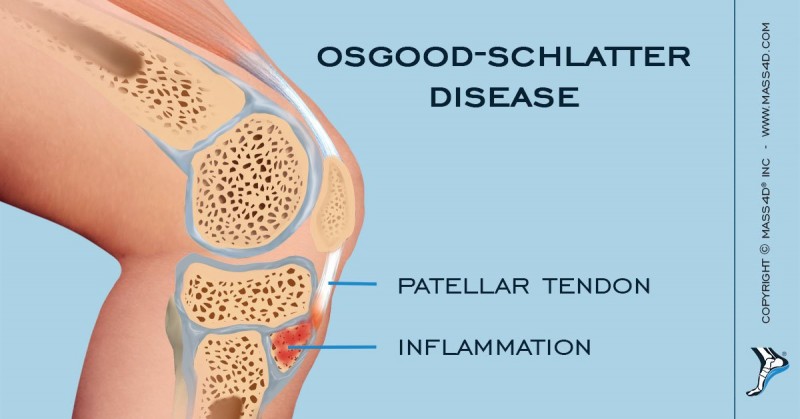While it is completely normal for those who are older to experience knee pain or even athletes who put a lot of stress on their knees; however, it is important to keep a close watch on the level of knee pain that youth experience. While not extremely common, the Osgood-Schlatter disease is a common cause of knee pain in adolescents that is characterized by inflammation and pain just below the knee where the kneecap attaches to the shinbone.
Most adolescents who experience this pain are often experiencing them through growth spurts when bones, muscles, tendons, and other important pieces of the skeletal and muscular systems are undergoing extreme, rapid changes and growth.
Normal growth with the knee and surrounding bones happens on growth plates, which are areas of cartilage located near the ends of bones. As a child reaches full growth, the growth plates harden from the cartilage into solid bone.Those with the disease, however, end up with inflammation in this area due to repetitive movements that pull at the growth plate. These children often end up with a prominent bump at the intersection of the knee cap and shin where the inflammation occurs.
Some symptoms that are likely to occur include:
- Knee pain and tenderness at the tibial tubercle
- Swelling at the tibial tubercle
- Tight muscles in the front or back of the thigh
This is especially prevalent in children who participate in athletic activities as the higher physical activity, increases the symptoms and risk of the condition.
If your child is experiencing any of these things, you should make an appointment with your child’s doctor. During the appointment, the doctor will discuss family history and general health as well as examine the knee for the cause of pain. This will include applying pressure to the tibial tubercle, which should be tender or painful for a child with Osgood-Schlatter disease, asking your child to walk, run, jump, or kneel to see if the movements bring on painful symptoms, and ordering an x-ray to confirm the diagnosis and rule out other problems.
The good news is that most who experience this disease can relieve the pain and return to daily activities through a combination of rest, over the counter medication, and regular exercises. Further, most children will grow out of the pain and discomfort once their growth spurt is over, though the bump will likely never leave.
For more information or if you have concerns about your child’s pain, make an appointment with their doctor or check out a local orthopedic.
This article is brought to you by Dr. Brandon Downs, of Orthopaedic Specialists, specializing in knee, hip and shoulder pain. Find Dr.Downs in Nashville, Dickson and Ashland City and online at Orthopaedicspecialists.com.
Locations:
1912 Charlotte Ave, Nashville 37203, (615) 590-8000
415 Henslee Drive, Dickson 37055, (615) 375-8287
313 North Main Street, Ashland City 37015, (615) 590-8000


















